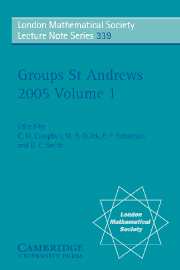Book contents
- Frontmatter
- Contents
- Introduction
- Aspects of infinite permutation groups
- Self-similarity and branching in group theory
- On surface groups: motivating examples in combinatorial group theory
- Nilpotent p-algebras and factorized p-groups
- Classification of finite groups by the number of element centralizers
- Algorithmic use of the Mal'cev correspondence
- Minimal but inefficient presentations for semi-direct products of finite cyclic monoids
- The modular isomorphism problem for finite p-groups with a cyclic subgroup of index p2
- On one-generated formations
- New results on products of finite groups
- Radical locally finite T-groups
- Explicit tilting complexes for the Broué conjecture on 3-blocks
- Conjugacy classes of p-regular elements in p-solvable groups
- An algorithm for the unit group of the Burnside ring of a finite group
- Integral group ring of the first Mathieu simple group
- Embedding properties in direct products
- Malcev presentations for subsemigroups of groups — a survey
- Finite groups with extremal conditions on sizes of conjugacy classes and on degrees of irreducible characters
- Conjugacy class structure in simple algebraic groups
- On automorphisms of products of groups
- Linear groups with infinite central dimension
- G-automata, counter languages and the Chomsky hierarchy
- An embedding theorem for groups universally equivalent to free nilpotent groups
- Irreducible word problems in groups
- Recent growth results
An algorithm for the unit group of the Burnside ring of a finite group
Published online by Cambridge University Press: 07 May 2010
- Frontmatter
- Contents
- Introduction
- Aspects of infinite permutation groups
- Self-similarity and branching in group theory
- On surface groups: motivating examples in combinatorial group theory
- Nilpotent p-algebras and factorized p-groups
- Classification of finite groups by the number of element centralizers
- Algorithmic use of the Mal'cev correspondence
- Minimal but inefficient presentations for semi-direct products of finite cyclic monoids
- The modular isomorphism problem for finite p-groups with a cyclic subgroup of index p2
- On one-generated formations
- New results on products of finite groups
- Radical locally finite T-groups
- Explicit tilting complexes for the Broué conjecture on 3-blocks
- Conjugacy classes of p-regular elements in p-solvable groups
- An algorithm for the unit group of the Burnside ring of a finite group
- Integral group ring of the first Mathieu simple group
- Embedding properties in direct products
- Malcev presentations for subsemigroups of groups — a survey
- Finite groups with extremal conditions on sizes of conjugacy classes and on degrees of irreducible characters
- Conjugacy class structure in simple algebraic groups
- On automorphisms of products of groups
- Linear groups with infinite central dimension
- G-automata, counter languages and the Chomsky hierarchy
- An embedding theorem for groups universally equivalent to free nilpotent groups
- Irreducible word problems in groups
- Recent growth results
Summary
Abstract
In this note we present an algorithm for the construction of the unit group of the Burnside ring Ω(G) of a finite group G from a list of representatives of the conjugacy classes of subgroups of G.
Introduction
Let G be a finite group. The Burnside ring Ω(G) of G is the Grothendieck ring of the isomorphism classes [X] of the finite left G-sets X with respect to disjoint union and direct product. It has a ℤ-basis consisting of the isomorphism classes of the transitive G-sets G/H, where H runs through a system of representatives of the conjugacy classes of subgroups of G.
The ghost ring of G is the set of functions f from the set of subgroups of G into ℤ which are constant on conjugacy classes of subgroups of G. For any finite G-set X, the function φX which maps a subgroup H of G to the number of its fixed points on X, i.e., φX(H) = #{x ∈ X : h.x = x for all h ∈ H}, belongs to (G). By a theorem of Burnside, the map φ : [X] → φX is an injective homomorphism of rings from Ω (G) to (G). We identify Ω (G) with its image under φ in (G), i.e., for x ∈ Ω(G), we write x(H) = φ (x)(H) = φH(x).
The ghost ring has a natural basis consisting of the characteristic functions of the conjugacy classes of subgroups of G.
- Type
- Chapter
- Information
- Groups St Andrews 2005 , pp. 230 - 236Publisher: Cambridge University PressPrint publication year: 2007
- 3
- Cited by

